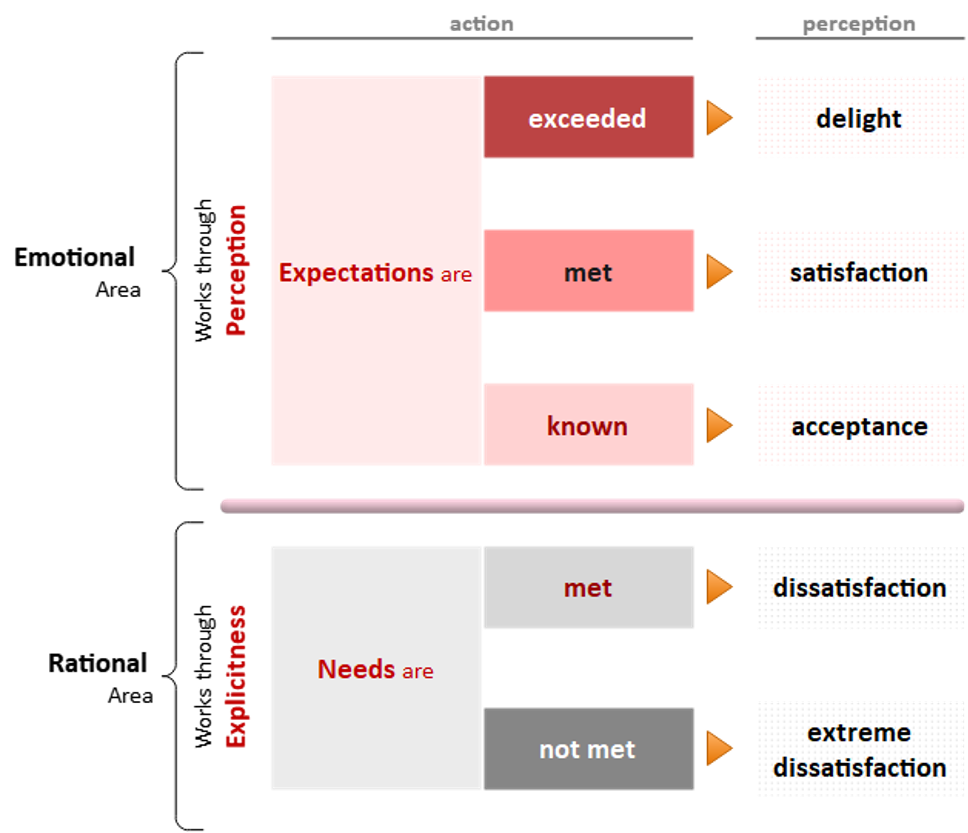
The Emotional Perception Scale
Consumption is driven by what consumers want or desire. Consequently, understanding this factor (consumer desire) is fundamental to business competitiveness.
Undoubtedly, much is already known and is being done to understand what consumers want. However, the paradigm shift from highly competitive markets to hypercompetitive environments makes it advisable to review those elements of competitiveness that need to be updated.
Rational vs. Emotional
The first factor to consider is that what consumers explicitly request is rationally "edited." Therefore, they are not expressing what they feel in their emotional sphere when asking for something. That premise indicates that we must establish two primary typologies of what consumers want: rational and emotional. In the former, we will include what they request explicitly, which we can call needs. The second group will be what they feel (emotional,) which we will call expectations. It is in that area where what customers desire can be found.
-
Needs: What a consumer expresses explicitly to have something they want.
-
Expectations: What consumers feel about something they want, which is rarely made explicit.
Satisfaction
Let's remember that the objective we pursue as a business is to become the reference in the market. To achieve this, we must make consumers like our offer much more than the competition's so they (consumers) will feel higher satisfaction by purchasing our products. Since "liking" is a phenomenon of the emotional sphere, it seems clear that if we limit ourselves to offering what a customer asks for, we will achieve a lower degree of satisfaction than if we align our offer with what the customer feels emotionally.
What do we know about emotions?
In the universe of polysemic concepts, emotions have a prominent place. For a business management model that aims to contribute effectively to competitiveness in very adverse situations, we must use the definition of emotions as rigorously as possible. That leads us, in the first place, to place them in the context of affective phenomena -following the structure of the component process model-1 where emotions are one of these phenomena, with specific characteristics that differentiate them from the other phenomena.
Secondly, emotions should be understood as "the affective phenomenon of high intensity and rapid change (short duration), by which a person automatically - not rationally - and consciously evaluates the relevance of perceived events, influencing the establishment of priorities and preferences." Therefore, we can manage them explicitly and not wait for them to happen randomly. Consequently, emotion fits the limited nature –mainly in the parameters of time and intensity— of an interaction between a member of the organization and a customer. However, it also follows from its short duration and rapidity of change that it will require scrupulous management of the mechanisms that we will have to use to produce them in the appropriate intensity and valence.2
This careful management of emotions refers, first of all, to their approach. They must be capable of producing a precise perception: our offer –which includes the people through whom it is conveyed— will be capable of satisfying "what the consumer likes most, what they want most." But, in addition, it must also be considered –for all the organic subsystems of the perceiver, the consumer in this case— as a significant event.
In summary, through a constant and coherent succession of emotions, our mind establishes preferences –what we will buy, among others. Thus, they contribute decisively to setting personal goals and priorities. Accordingly, a business can make customers prioritize its products over the rest of the available offerings. As emotions are dimensional, mainly in intensity and valence, a business can adapt and graduate them according to competitive needs.
Finally, it should be noted that emotions are antagonistic to reason, protecting the individual from narrow conceptions of rationality as much as they are indispensable for the quality of life.
In conclusion, our competitive model will have to generate the right emotions to satisfy or delight customers and thus establish ourselves as their preference. Therefore, the questions to be answered are: what are these emotions, and how will they be obtained?
Liking or disliking are relatively stable evaluative judgments expressing a preference. No one chooses or buys something they do not like. Liking is, before price or quality, the Õrst factor the consumer will consider -consciously, but not rationally- to "approach" the product offered. However, this does not prevent that, given the same offer, he will normally prefer the one with the lowest price and the highest quality. But, beyond the ability to generate an excellent offer at competitive prices, if a brand wants to prosper efficiently in a highly demanding market, it must go deeper into the concept of generating attraction or desire for its products.
When a person perceives an event related to "something" -e.g., a product offered by a seller- that they have made explicit (need,) the stimulus generates practically no satisfaction (low-intensity emotion). Consequently, the sensation of liking it will be shallow. On the contrary, when the emotion has been provoked by an event related to something that a person"really wanted" but that hardly can/want to make explicit (expectation,) the perception of liking (satisfaction) will be more intense and long-lasting.
From this principle, we can establish that one of the critical characteristics to differentiate emotional perceptions -mainly generated by the interaction between people- is not the greater or lesser relevance of what is being talked about but its degree of explicitness.
For some reason (whose explanation corresponds to another type of discipline), people have a block (conscious or unconscious) when it comes to expressing what would satisfy them most (expectation). However, this does not mean they do not desire it; quite the contrary. Consequently, the emotional effect will be much more signiÕcant if it is established based on satisfying -or exceeding- an expectation than if it is only focused on a need. In conclusion, the ability to be "liked" and, consequently, "preferred" will be proportional to the ability to generate the perception of being able to satisfy -or exceed- consumer expectations.
Broadly speaking, this is how the emotional perception of a person -read consumer or customer- works, which, as everything affective, encompasses a wide range of intensities. This difference in intensity in the perception of an event forms a scale of emotional perception by which we can determine the perception generated by the consumer.
From this reasoning, we can infer that, although in absolute terms, customers may feel satisfaction when they get what they asked for, in comparative terms (with what they feel on an emotional level), they will not be sensing true satisfaction. Even if it is slight, the feeling will be one of dissatisfaction. That is because consumers expect "something" more (even if it is very little) for what they consider basic, in this case, needs. Let us take a closer look at what this antithetical phenomenon consists of. "We have fulÕlled what was asked of us." Compared with the available offer -abundant in hypercompetitive environments- the customer's perception will not be that he has received "something special." Usually, their emotional conclusion will be something like: "For what I paid, I could have...". That occurs through a virtually inevitable process of systematic comparison precisely because what the competition offers is also attractive to our customers in markets of exacerbated competition. On the contrary, the perception that we are making an effort to offer them (consumers) something much more in line with their feelings will generate a better perception than the fact of serving what they requested.
However, the feeling of customer satisfaction does not occur even if we know their expectations; at this level, the perception they have is pleasant, one of conformity. Customers' satisfaction with purchasing our products only occurs when we can meet their expectations. Only at this point can we speak of creating a stable, lasting, and growing emotional bond. And, if we do not let up in our efforts, we will reach the maximum level of this emotional scale, "delight." This sensation is produced when our client's expectations are not only satisÕed but exceeded.
In conclusion, the different emotional states are caused by each customer's perception of how their needs or expectations are met.
What do we know about perception?
Perception occurs through the dynamics of a person’s sensory channels. The energy perceived through the human senses is the origin of emotions. Consequently, emotions are energy (emotional), so the essential characteristics and laws of emotional energy must be considered.
The first characteristic of emotional energy to be considered is integrity, which means that only what is real can be perceived. Given that emotional energy is transmitted by wave motion (or vibration.) if the vibration of behavior has a negative valence (in terms of energy,) so it is what will be perceived by other people. That means, for example, that a smile cannot hide a bad mood. On the contrary, (e.g.,) the positive energy with which a person does something will also imbue it as a requisite for its perception.
Besides integrity, within the emotional area, the following properties of the energy must be particularly respected:
-
Polarity—Energy has two valences or poles with opposite qualities (+/-), and each vibrates in a single direction. One of the consequences of that characteristic is that positive energy is incompatible with negative energy.
-
Continuity—Energy is continuous. Hence, to obtain the expected effects of an adopted behavior, it is necessary to favor its flow steadily.
-
Dispersion—Energy tends to chaos and diffusion when it is in its natural state. Focusing persistently in a particular direction requires a consumption of energy.
-
Proportionality—The more intensely behaviors are adopted (action), the greater the return (reaction). Similarly, reaching a specific outcome requires focusing on the action but not the reaction.
Satisfaction is not giving more
But we must pay attention here. If we meet customer expectations, it is because we have made an extraordinary effort in human and organizational development, solving the dilemma of knowing what has yet to be made explicit. All this can be lost if we confuse exceeding expectations with adding more.
Meeting or exceeding customer expectations means we are working on their emotional line, not ours, not in "what we think." Thus, meeting or exceeding expectations will mean that we profoundly understand the customer's preferences rather than assuming or inventing what they want. If we give him more of something, but he does not want it, the emotional cycle stops and, if not remedied in time, will begin to reverse.
1 The component process model method has been developed by Professor Klaus R. Scherer and published in the article "Trends and developments: research on emotions"; Social Science Information, SAGE Publications 2005.
2 The term “valence” is understood as of positive or negative nature.
Appraising customer’s perception
Summarizing what we have seen so far, the perception of customers who wish to purchase a product materializes in one of the following emotional perceptions,3 from the most negative to the most positive: (1) dissatisfaction, (2) slight dissatisfaction, (3) pleasant, conformity (4) satisfaction, and (5) delight.
On the premises of those perceptions, we can begin to structure a scale that allows us to become aware of the level of customer satisfaction we can generate.
| Group | Fulfilment | Perception | Value |
|---|---|---|---|
| Need | Not met | Insatisfaction | -1 |
| Need | Met | Slight Insatisfaction | 0 |
| Expectation | Known | Pleasant | 1 |
| Expectation | Met | Satisfaction | 3 |
| Expectation | Exceeded | Delight | 9 |
In order to build charts to monitor customer satisfaction, a specific value is assigned to each level of the scale, which in a graphic format could be as follows:

3 The suggested levels of perception have been extracted from ieldwork carried out in customer listening processes for more than 20 years in different countries and about 190 different types of businesses.